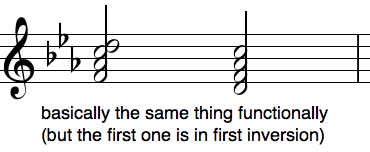|
Question: My question concerns the chord F - Ab - C - D in the key of C minor (a iv chord with a sixth added). Since this chord contains the same notes as the half-diminished chord built on ii (that is, D - F - Ab - C), is there any actual difference in the harmonic functions of the two chords, apart from a difference in bass note? It seems to me that both chords will precede the dominant, 9 times out of 10, as part of a standard cadence in minor -- iv V i or ii (altered) V i. As a pop musician, I would use them interchangeably, depending on which voicing fits the tune better. So is there any real difference? - J.
Answer: Nah. Traditional music theory basically doesn't consider there to be such a thing as a chord of the added sixth. In C minor that chord would be ii half-dim 7 and that's all there is to it. And dim chords often appear in first inversion, too, so you'd even expect to see it with F as the bass. Functional harmony just doesn't recognize that sixth chord as worthy of any special attention. The analyzed root remains D in this case and that's how you'd label it in school. And that's why those two voicings are pretty much interchangeable; they are functionally the same chord. 
|


